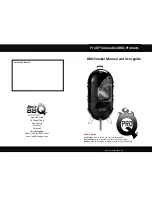
7
If your listening position is close to the wall behind
you, mount some sound absorbent material, such as a
hanging tapestry, directly behind your head. As with the
material for the side walls, experiment with a folded natu-
ral-fiber blanket to verify the results before you acquire or
mount the material.
Bass problems that cannot be corrected with placement
adjustments may be helped by the addition of bass traps or
other bass control devices. Follow the instructions of the
bass control devices as to their proper set-up and place-
ment to correct the problems you are experiencing.
In our 14 by 18 foot example room, the thirds are 72
inches in the long dimension and 56 inches in the short di-
mension. The intersections of these measurements are used
for third dimensions placement. In addition, the listening
position is placed 72 inches from the rear wall of the room.
Both speakers should be tried up to two inches ahead and
behind the intersections to determine if this improves the
sound. Both speakers should be moved the same amount
forward or backward.
Third dimensions placement reduces the interaction of
the speakers with the room to an absolute minimum, but can
create aesthetic or room function problems due to the speak-
ers and listening position being so far out in the room. (The
lower the odd number used to divide the room dimensions
the lower the interaction between the speakers and the
best placed on a short wall while in other rooms the speakers
will work better on a long wall.
T
HIRD
D
IMENSIONS
P
LACEMENT
A placement method that provides some unique effects is
to place each speaker on the thirds of the room measure-
ments and the listening position on the third of the length.
The speakers are placed one third the length of the room
from the wall behind them and one third the width of the
room from the walls along side them. The listening position
is then placed one third the length of the room from the wall
behind it.
A
COUSTICAL
C
ENTER
The Model Treo's acoustical center is the physical center
of the loudspeaker. In a perfectly rectangular room with
absolutely rigid walls and no doors or windows, the
acoustical center of the loudspeaker would be placed exactly
at the point where the two dimensions inter-
sect to realize the full benefits of odd dim-
ensions or third dimensions placement. In a
real room, the actual best placement may
vary from the intersection by as much as two
inches or so. Fine-tuning the placement by
moving the speakers a couple of inches of the
Odd dimensions intersections takes these real
World conditions into account.
You should not use any placements that
put the acoustical center of the loudspeaker
the same distance from the rear and side
72
56
56
Listening
Position
72
walls. The measurement from the center of the loud-
speaker to the two walls should differ by at least two
inches. If any of the odd dimension intersections are
within two inches of the same distance from both the side
and rear wall, you should not use them.
S
PEAKER
T
OE-
I
N
The degree of toe-in can affect the imaging and re-
sponse characteristics of the speakers. In most rooms, the
speakers will work well facing straight ahead or with a
slightly toe-in. Speakers that are placed close to the side
walls or in rooms with very reflective side walls may re-
quire additional toe-in to avoid a confused image and/or a
forward midrange and treble.
If the speakers need an excessive amount of toe-in to
image properly or achieve good center fill, there may be a
problem with the set-up or connection of the speakers or
some part of the system may not be functioning as in-
tended. To determine why the speakers require excessive
toe-in, check all your speaker wire connections for correct
phase and verify that the electrical components in the sys-
tem are connected and functioning properly.
A
COUSTIC
T
REATMENTS
If the speakers are close to the side walls and you hear a
brightness in the midrange/treble or a problem with the
imaging that toeing-in the speakers does not help, some
sound absorbent material should be mounted on the side
walls to control reflections.
to determine where the sound absorbent material should
be placed, imagine that the walls are mirrors and mount the
material on the walls where you would see the reflections
of the speakers when you are sitting in your normal listen-
ing position. Before you actually mount anything on the
side walls, experiment with folded natural-fiber blankets to
verify that you will get the results you desire.
Speaker
Speaker
Listening
Position






























